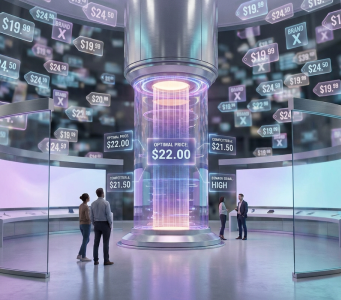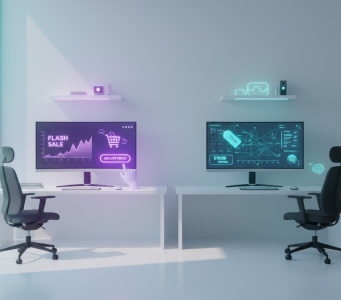Seeing Through the Noise Competitive Intelligence for Eyewear Brands in a Crowded Market
Seeing Through the Noise Competitive Intelligence for Eyewear Brands in a Crowded Market
The eyewear market has become more complex than ever. Once dominated by a few global players, it is now saturated with fast-fashion lines, direct-to-consumer disruptors, private-label collections, and niche designers. These players are all competing across digital shelves and physical retail.
For established brands and new entrants alike, the biggest challenge isn’t just being seen. It’s about staying relevant. And in a market this fragmented, staying relevant requires more than stylish frames and trend-right color palettes. It demands visibility into your competitors, your positioning, and your pricing architecture across channels and regions.
This is where competitive intelligence becomes a brand’s sharpest lens. To understand how brands can regain control in such a competitive space, we need to look at the complexity of the landscape they’re navigating.
The Blurred Landscape of Eyewear Retail
The modern eyewear space is no longer linear. Frames are sold in luxury boutiques, optical chains, online marketplaces, and branded websites. Product catalogs are refreshed more frequently, with SKUs rotating seasonally. Private labels mimic premium designs at a lower cost. Price transparency through comparison tools and search engines has made consumers more informed and far more selective.
This convergence of fashion, function, and omnichannel distribution has made visibility into the market incredibly difficult.
To make pricing, assortment, and promotional decisions with confidence, eyewear brands need consistent insights into where they stand, who they are up against, how their products compare, and what strategies competitors are using.
Finding clarity in this complexity requires consistent, structured, and intelligent competitive tracking. Given this speed and complexity, traditional ways of tracking competition simply fall short.
Why Static Benchmarking No Longer Works

Many brands still rely on quarterly reports or internal audits to benchmark pricing and assortment. These methods are too slow, reactive, and often incomplete. They cannot keep up with the constant stream of product launches, regional pricing changes, or promotional shifts that occur weekly or even daily.
In a category where price sensitivity varies based on frame material, prescription complexity, or style, outdated data does more than slow you down. It creates risk. You miss opportunities or lose margin because you’re working from yesterday’s information.
To remain competitive, eyewear brands need tools that can monitor the market dynamically and surface meaningful changes in pricing and product positioning.
Static benchmarking simply doesn’t meet the pace of modern retail. Even when you have the data, making meaningful comparisons across products is far from straightforward.
Intelligent Matching Across Product Variants
Matching eyewear products across different brands is a complex task. SKUs often differ by lens coating, frame color, or naming convention. Private labels intentionally avoid standard identifiers. This makes side-by-side comparison difficult unless you’re using advanced AI.
Hypersonix’s CommerceLLM and Agentic Matching solve this through a layered approach. These technologies analyze descriptions, images, product attributes, and context to identify matches and substitutes even when branding and materials differ.
For instance, two matte black acetate frames may look almost identical. But if one is priced 40 percent higher, understanding the reason becomes critical. With intelligent matching, brands can uncover:
- Their pricing position relative to comparable frames
- Whether they lead or lag in materials or style segments
- How their value proposition holds up against lower-priced alternatives
With this kind of visibility, brands can move beyond guesswork and start making precision-driven decisions.
But understanding what you’re up against is only half the battle. Where and how competitors show up across markets adds another layer of complexity.
Visibility Across Retail Channels and Geographies
It’s not only about who your competitors are. It’s also about where and how they are pricing. Eyewear prices often vary between specialty retailers, online marketplaces, department stores, and regional optical chains.
Hypersonix Competitor AI enables brands to track competitor data on a schedule that fits their needs—daily, weekly, or monthly—and to break it down by geography and channel. This makes it possible to answer high-impact questions such as:
- Are competitors offering markdowns in select urban markets?
- Are hero SKUs being undercut on platforms you don’t directly control?
- Are bundles or promotions making your core products seem overpriced?
This type of channel and region-specific clarity allows brands to act quickly and prevent erosion before it impacts performance.
Channel-level and regional pricing matter, but so do the promotional tactics that influence shopper behavior and perception.

Tracking Promotions Before They Eat Into Your Share
Promotions are frequent in eyewear, especially during seasonal resets or around insurance deadlines. But not all promotional activity is easy to spot unless you’re tracking the right sources.
Competitor AI identifies not only price drops but also promotional tactics such as bundling, time-limited offers, and discount placement. It also captures how these offers are positioned and which customer segments they target.
This insight enables brands to respond intelligently, matching when it’s profitable, countering when it’s strategic, or holding firm when the data supports doing so. Over time, it helps identify which competitors are consistently discounting, how aggressive those strategies are, and what impact they have on your market position.
Promotions without intelligence are a risk. With visibility, they become an advantage.
All of these data points pricing, product matching, and promotions; become truly valuable when they guide better decision-making across your teams.
Results That Matter, Fashion Brands in Control
Fashion brands using Hypersonix have seen:
- Up to 6% margin improvement by resisting unnecessary discounts.
- 40% faster pricing decisions, reducing lag between detection and action.
- Better promo ROI, with fewer promotions delivering more impact.
- Higher price confidence among category managers and buyers.
One fashion brand used Competitor AI to time their promotional window for summer dresses based on when competitors were winding down campaigns—maximizing visibility without entering a crowded markdown race.
Another used price tracking to identify where marketplace sellers were undercutting their own DTC pricinga nd used Pricing AI to bring price parity and control back.
Ultimately, staying ahead of fashion trends isn’t just about launching the right look, it’s about backing that look with pricing that resonates. With Hypersonix, brands can do exactly that with confidence.
From Market Visibility to Strategic Clarity
Competitive intelligence is more than price tracking. It’s a strategic capability that informs smarter decisions across teams—whether it’s pricing, product, merchandising, or marketing.
When pricing teams can track similar products in specific markets, they act faster and with more confidence. When product teams see assortment gaps or emerging trends, they can respond with targeted launches. When marketing understands how premium-tier products compare to private labels, they can sharpen messaging and protect brand equity.
The more you know about the competitive environment, the more effective your strategy becomes.
Ultimately, the brands that succeed are the ones that can cut through the noise and respond with clarity and confidence.
In a Crowded Market, Clarity Wins
The eyewear industry isn’t getting less competitive. Direct-to-consumer brands are scaling up. Private labels are climbing into premium territory. And consumers are expecting better design, value, and service from every direction.
Brands that can see clearly—those who understand who their competitors are, what they are charging, and how the market is evolving—will outperform those still operating with partial views.
With solutions like Hypersonix Competitor AI and CommerceLLM, eyewear brands gain the insight needed to rise above the noise and move with confidence.
In today’s crowded market, clarity is no longer a luxury. It is the key to sustained growth.

.png)



